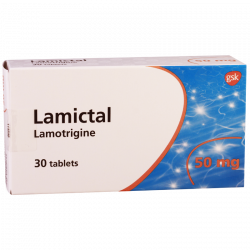Lamictal (lamotrigine) Coupons, Discounts & Cost
Lamictal (lamotrigine) belongs to the group of anticonvulsants. One way to save money on the Lamictal (lamotrigine) retail cost regardless of income and insurance status is to use Lamictal coupons or discount cards from RXCoupons. Use our Lamotrigine coupons at your online pharmacy and receive up to 75% off the sale price each time you refill your prescription.
What is Lamictal (lamotrigine)?
Lamictal (lamotrigine) belongs to the group of anticonvulsants. It is widely used in the treatment of epileptic seizures and seizures of unknown etiology. Lamotrigine affects the ability of neurons to release glutamate and helps reduce the spontaneous activity of neurons in the epileptic focus.
Lamictal is indicated for the treatment of epilepsy. It is used as monotherapy in typical absence seizures.
Patients older than 12 years: as monotherapy and as part of a combined treatment of partial and generalized seizures, including tonic-clonic seizures and Lennox-Gastaut syndrome.
Children 3-12 years: combination therapy of partial and generalized seizures, including tonic-clonic seizures and Lennox-Gastaut syndrome.
In addition, patients older than 18 years with bipolar affective disorder can take this drug for the prevention of mood disorders (hypomania, mania, depression, mixed episodes).
When I should NOT take Lamictal (lamotrigine)?
Lamictal is not prescribed for the treatment of bipolar disorder in patients younger than 18 years. It is not used in case of hypersensitivity to the drug.
Lamictal is prescribed with caution in the following cases: patients with renal insufficiency, during pregnancy and breastfeeding (it is possible only if the expected benefit outweighs the potential risk to the child).
How should I use Lamictal (lamotrigine)?
The tablets are taken whole with water, without breaking or chewing. The dosage is prescribed by the physician (based on clinical indications).
The recommended dosage for patients older than 12 years: initial dose for monotherapy - 25 mg 1 time a day for 2 weeks followed by 50 mg 1 time a day for 2 weeks. The dose should be increased by 50-100 mg every 1-2 weeks (sometimes up to 500 mg per day) for optimal clinical effect. Maintenance dose - 100-200 mg per day (1-2 doses). Combination therapy with valproic acid and other antiepileptic drugs: initial dose - 25 mg every other day for 2 weeks followed by a dose of 25 mg once a day for 2 weeks. The dose should be increased by 25-50 mg per week in order to achieve optimal clinical effect. Lamictal maintenance dose - 100-200 mg per day (1 or 2 divided doses).
Combination therapy (without valproic acid) with phenytoin, carbamazepine, phenobarbital, primidone and other antiepileptic drugs: initial dose - 50 mg 1 time per day for 2 weeks, then - 50 mg two times a day for 2 weeks. The dose can be increased by 100 mg at intervals of 1-2 weeks to achieve the desired therapeutic effect. Maintenance dose - 100-200 mg 2 times a day.
The recommended dosage for children 2 to 12 years in combination with valproate and other antiepileptic drugs: initial dose - 0.15 mg per 1 kg body weight once daily for 2 weeks. Supportive daily dose: 1-5 mg per 1 kg of weight once or twice daily, but not more than 200 mg per day. Combination with other antiepileptic drugs (carbamazepine, primidone, phenytoin, phenobarbital) except valproate: initial daily dose - 0.6 mg per 1 kg body weight twice daily for 2 weeks, and after that - 1.2 mg per 1 kg body weight in 2 divided doses for 2 weeks. Supportive daily dose - 5-15 mg per 1 kg twice daily, but not more than 400 mg per day.
Lamictal (lamotrigine) Adverse reactions
Nervous system: often - fatigue, irritability, headache, anxiety, drowsiness, dizziness, insomnia, nystagmus, ataxia, tremor; rarely - hallucinations, agitation, movement disorders.
Dermatological reactions: often - skin rash (usually appears during the first two months of therapy); rarely - toxic epidermal necrolysis (Lyell's syndrome), Stevens-Johnson syndrome.
Digestive system: often - dysfunction of the gastrointestinal tract (nausea, vomiting, diarrhea); rarely - liver damage.
Blood and lymphatic system: rarely - anemia, neutropenia, pancytopenia, leukopenia, aplastic anemia, thrombocytopenia, agranulocytosis.
Musculoskeletal system: often - back pain, arthralgia; rarely - lupus-like syndrome.
Immune system: rarely - hypersensitivity syndrome (fever, facial swelling, lymphadenopathy, hematological disorders, liver failure).
Other: blurred vision, diplopia, conjunctivitis, rhabdomyolysis.

